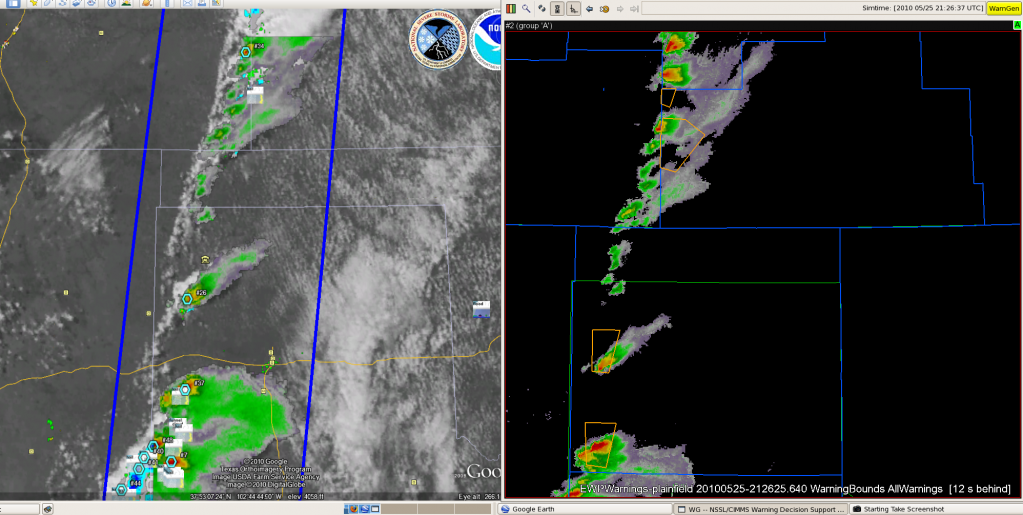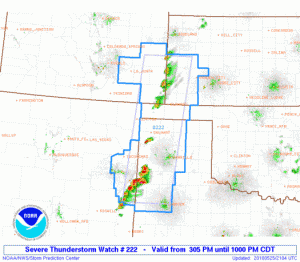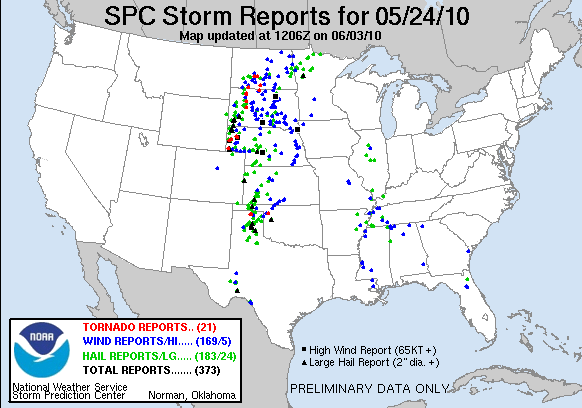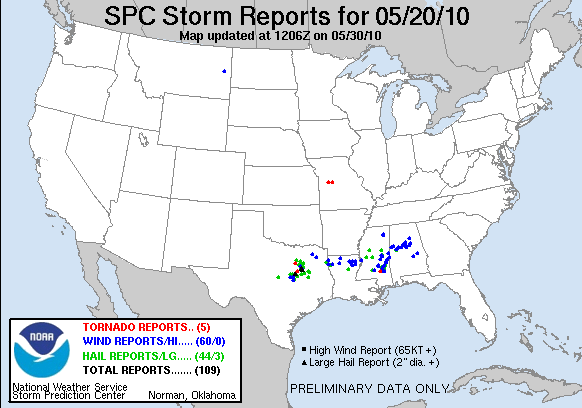SUMMARY:
Week #6 of EWP2010 wrapped up the first week of MRMS and GOES-R experimentation. This week included another Central Oklahoma High Risk adventure, however our Lightning Mapping Array was down for repairs. During this week, NSSL and the GOES-R program hosted the following National Weather Service participants: David Blanchard (Flagstaff, AZ), Matt Kramar (Sterling, VA), Ken Pomeroy (Western Region HQ, Salt Lake City, UT), and Darren Van Cleave (Rapid City, SD) .
REAL-TIME EVENT OVERVIEW:
17 May: “Practice” IOP for some severe storms in Midland’s CWA.
18 May: Isolated TX Panhandle tornadic supercell that V2 followed, plus other supercells in Pueblo’s CWA.
19 May: First full day (6 hour) IOP, with Central OK High Risk tornadic supercells.
20 May: Early IOP in Fort Worth’s area, later IOP exploiting the Alabama LMA.
MRMS:
Forecasters felt that it was more efficient to issue the warnings using the MRMS data versus having to check storms out for three different radars. Was easier to follow estimated hail size in SVSs. And the tracks products were very good at aligning the polygons.
However, we learned early on this week that the initial load time for the experimental MRMS products was excruciatingly slow. Turned out to be a product of many issues on the system, including a bad network connection on the motherboard, which was replaced with a 1 Gbit network PCI card. But the issues intermittently persisted. We also moved the location of the MRMS data storage to the main server, and that helped but didn’t completely solve the problem. Looking beyond this issue, once the products were initially loaded via procedures or otherwise, they usually updated automatically with no delays. [NOTE: It turned out that we weren’t able to find one of the major sources of the problem until the final week of EWP2010.]
One of the advantages of a MRMS system is to better diagnose storms that go directly over a single radar, into their cone-of-silence. This happened several times during the week. For the hail diagnosis parameters, the MRMS system did a great job of filling in the cones-of-silence from adjacent radars. However, for the rotation tracks/azimuthal shear products, it was more problematic. The reason was that the az shear products have a limitation close to radars due to the extreme elevation angle of some of the cuts within the 0-2 km layer, and the detection of the vertical component of the shear. NSSL will work on this issue after the experiment.
By the end of the week, some of the forecasters commented that their familiarity with some of the MRMS products was enough to start trusting them and be more comfortable using them.
Some suggestions for new products were to 1) take care of the change in severe hail size threshold from 3/4″ to 1″ (e.g, 60 dBZ Echo Top), and 2) to deal with severe wind. Both of these issues will be considered after the experiment.
GOES-R:
The convective initiation (CI) products were hampered by cirrus several times. In addition, they were not very sensitive – in other words, there were usually detections after radar indicated new convection, so there wasn’t much heads up. It was noted that their greatest value was on the very first storm of the day.
The Overshooting Tops (OT) and Thermal Couplet (TC) algorithm didn’t seem quite useful. Storms were already known to be severe, based on radar, when an OT detection was had. The signatures were also seen using visible satellite, and an algorithm wasn’t too useful. However, the forecasters suggested that it might be more useful where there is a lack of radar coverage or at night when visible satellite coverage is nil. The developers also mentioned that the increased temporal and spatial resolution of GOES-R would make for better detections. There is also work underway to attach OT and TC info to storm cluster detections (NSSL work) in order to provide time trends of these attributes.
The 8 km resolution Pseudo Geostationary Lightning Mapper (PGLM) data were viewed during the 24 May 2008 archive event as well as the real-time Alabama event. In both cases, the data resolution was greatly smoothed by the AWIPS volume browser. It turns out that 1) the WDSSII grids were not being resampled to 1 km resolution as they were last year, and 2) the AWIPS volume browser had grid objective analysis (smoothing) turned on. Both of these issues were fixed after this week.
There are more details on the GOES-R HWT Blog Weekly Summary.
OVERALL COMMENTS:
This is the first year we tried “double IOPs”, lasting more than 3 hours (more like 6-7 hours). The forecasters were fine with this, commenting that it was more like real WFO operations. One of our veteran forecasters once again suggested that participants really need to be here for two weeks instead of one to get more out of the experiment, and be most spun up with the new products. Another veteran thought that having the data already in AWIPS makes the transition much easier on the forecasters. Finally, they suggested that the training be developed prior to the start of the experiment, perhaps as 20-min Articulate presentations made in collaboration with WDTB.
A LOOK AHEAD:
Next week looks good in terms of potential for severe weather nearly anywhere in the central or eastern U. S. on each day.
Greg Stumpf, EWP2010 Operations Coordinator
17 May: “Practice” IOP for some severe storms in Midland’s CWA.
18 May: Isolated TX Panhandle tornadic supercell that V2 followed, plus other supercells in Pueblo’s CWA.
19 May: First full day (6 hour) IOP, with Central OK High Risk tornadic supercells.
20 May: Early IOP in Fort Worth’s area, later IOP exploiting the Alabama LMA.





